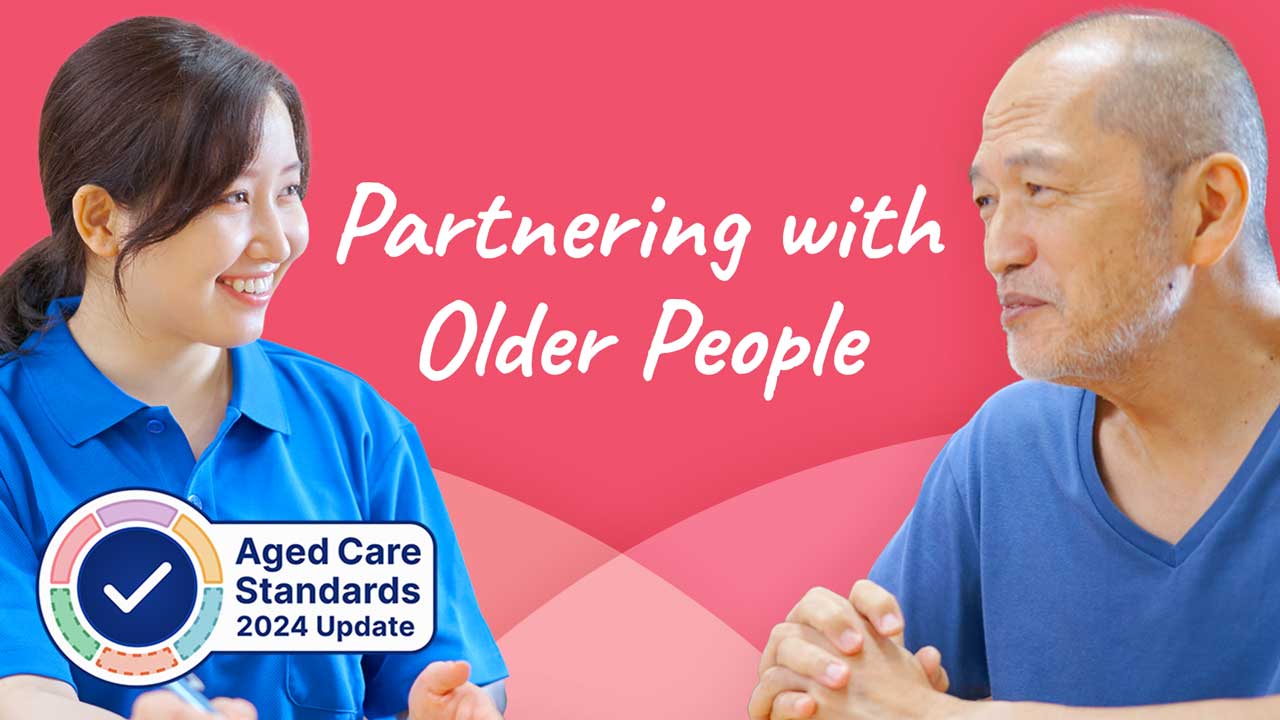Partnering With Older People
Published: 02 May 2024

Published: 02 May 2024

Partnering with older people is more than just a buzzword - it’s a fundamental right. Being able to make decisions about our own lives and having those decisions respected is something that the Aged Care Quality and Safety Commission (ACQSC) is ensuring that all aged care recipients are provided (2023).
Partnering in aged care is about working alongside older people to tailor care that respects their individual preferences and goals. From simple conversations to structured forums and systems for feedback, this article considers how providers can effectively partner with older people in their care.
Providers are expected to work alongside older people in order to plan care and services that meet their needs, goals, and preferences (ACQSC 2023).
Even if an older person is experiencing challenges in their life, providers should support them to achieve their goals and live meaningfully while maximising their quality of life (ACQSC 2023).
Partnering with clients involves communicating with the person about their preferences, assessing their abilities, and then delivering care that allows them to fulfil their goals. Plans should be regularly reviewed in order to identify changes in the person’s circumstances and adjust care and services accordingly (ACQSC 2023).
Working in partnership with older people and empowering them to actively participate in planning their care is an essential component of person-centred care (ACQSC 2024a).
Partnerships can be facilitated through:
(ACQSC 2024b)
Partnering with older people is an essential concept in the strengthened Aged Care Quality Standards.
Under Standard 1: The Person - Outcome 1.1: Person-centred care:
(ACQSC 2024b)
Standard 2: The Organisation - Outcome 2.1 Partnering with older people aims to ensure the organisation is actively collaborating with the older person to guarantee ongoing and meaningful improvement. It focuses on the key concepts of:
(ACQSC 2024c)
Under Standard 3: Care and Services:
(ACQSC 2024d)
(ACQSC 2023)

Taking a person-centred approach means being a good listener and understanding what the older people in your care want to gain from their own lives. Your role is to explore options and solutions to guide them towards their goals rather than enforcing what you think is best for them (Donna 2019).
Consider the person’s:
(Donna 2019)
Partnering with older people, their loved ones, and other parties involved in their care is an important part of care planning and review (ACQSC 2024a).
The outcomes of assessment and planning are expected to be documented in a care and services plan, which should be kept accurate and current. A care and services plan may comprise one or several documents and should be available to both the provider and older person when needed (ACQSC 2023).
The plan should include the person’s needs, goals, and preferences and may also include advance care planning (ACQSC 2023).
The goal of care plans is to:
(Gramenz & Dymock 2023)
Care plans must be readily available to the person and their loved ones (Gramenz & Dymock 2023).
The provider and older person should agree on a review date for the care plan depending on the person’s needs and the services being provided (ACQSC 2023).
Part of planning with older people means providing them with resources and support to complete end-of-life planning and advance care directives if they wish to do so. This will allow the person to inform their end-of-life experience, saving carers, staff, and loved ones from unnecessary distress if the discussion is left too late (ACQSC 2023).
If the person does not have decision-making capacity, their designated substitute decision-maker can assist in developing an emergency care plan (ACQSC 2023).
Once completed, this documentation is expected to be accurate, up-to-date, and properly stored (ACQSC 2023).

Providers should work together with older people receiving care and services at home to develop an emergency plan. As the carer may not always be present, it’s essential that the older person knows what to do in such a situation.
(palliAGED 2021)
A key component of planning care with older people is identifying and setting goals that reflect their personal and clinical needs, preferences, expectations, and aspirations. Goal-setting improves people’s satisfaction, quality of life, and self-efficacy (ACSQHC 2019).
While a conversation with the client about their values and preferences may suffice at a minimum, you may also utilise tools, frameworks, models, or person-centred communication models in order to identify goals. These goals should then be used to inform the older person’s care (ACSQHC 2019).
The following principles should be used when identifying and setting goals:
(ACSQHC 2019)
Providers are expected to regularly review care plans to ensure:
(ACQSC 2023)
Plans should be reviewed when:
(ACQSC 2023)
Question 1 of 3
Which one of the following is a goal of care plans in aged care settings?